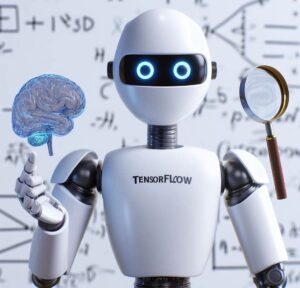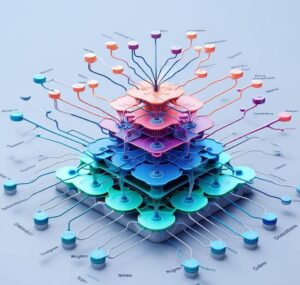TensorFlow in Machine Learning

Machine Learning (ML) stands as one of the core facets of Artificial Intelligence, designed to build systems that imbibe knowledge or enhance their performance from the data they encounter. At its heart, machine learning constructs computational models to predict outcomes, learn from errors, and progressively improve over time. TensorFlow, in no simple terms, has become a cornerstone in machine learning strategies.
The reason behind TensorFlow’s success in machine learning is multifaceted. One of the top advantages is its ability to create easy algorithmic modeling. TensorFlow allows developers to create complex, multilayered neural network models effortlessly. It provides the toolkit needed for designing a wide range of algorithms, regardless of their complexity. Its flexibility and scalability allow developers to create simple to advanced models for various types of Machine Learning, including supervised, unsupervised and reinforcement learning.
One of the critical contributions of TensorFlow is that it enables effortless implementation of back-propagation – a fundamental method for training neural networks. Back-propagation adjusts the weights of the connections in a neural network through gradient descent, reducing errors and improving prediction accuracy. This makes constructing all types of machine learning models easier and accelerates the development and optimization process. This streamlining is vital, given how intrinsic neural networks are to several machine learning algorithms.
TensorFlow’s contributions have supercharged the operations of Google’s RankBrain. This search engine algorithm, pivotal in providing online query results, uses TensorFlow to enhance its functionality. By learning from the data of previously searched user queries, RankBrain juggles a multitude of factors to extract the relevance and then prediction the possible meaning of unencountered queries. In turn, TensorFlow aids RankBrain to continually learn and improve the search outcomes. It powerfully demonstrates how TensorFlow can be leveraged to optimize machine learning models for practical applications.
TensorFlow’s pivotal role in machine learning cannot be overstated. Whether the necessity is for creating complex models or enabling the smooth execution of back-propagation for neural network training, TensorFlow answers these needs. By bringing such capabilities to the table, TensorFlow remains a significant player in the rapidly developing machine learning landscape. Indubitably, it will continue to play an enormous role in future ML advancements.
Advancements in Deep Learning with TensorFlow
Deep Learning (DL), a subset of machine learning, deals with algorithms inspired by the structure and function of the brain called artificial neural networks. TensorFlow’s capacity to handle big data and process it over various computational resources makes it an invaluable tool for deep learning applications. It provides the TensorBoard that helps in visualising the machine learning models, which can be handy while debugging the neural network. Furthermore, a real-world case study could be the inception model developed for ImageNet which uses TensorFlow for classifying images into a thousand categories.
Real-World Applications of TensorFlow in AI
The real-world applications of TensorFlow in AI scenarios are flourishing more than ever. TensorFlow, with its flexible and versatile nature, is transforming industries, including but not limited to healthcare, transportation, and communication.
One of its primary applications is in the realm of voice and image recognition systems. For instance, Google Translate, a popular language translation application, deploys TensorFlow for translating images of text in different languages. By employing complex neural network models, TensorFlow aids in analyzing the text in an image – a unique form of Optical Character Recognition (OCR). After extracting the text, the language is identified using pattern matching and then translated into the user’s preferred language. This powerful combination of image recognition and language translation makes it possible to understand foreign language signs or documents in real-time.
In the domain of natural language processing, TensorFlow is a driving force, helping machines understand and communicate in human language. This enhancement in machine-human interaction is critical, giving machines the ability to respond intelligently to user queries, increasing customer engagement and improving user experience. It can be seen in chatbots and virtual assistants, as they utilize TensorFlow to process language, recognize speech patterns, and generate human-like responses.
In the field of autonomous vehicles, TensorFlow plays a crucial role. These vehicles rely heavily on interpreting sensory data to safely navigate roads, avoid obstacles, and make accurate decisions. TensorFlow’s ability to handle large volumes of data from multiple sensors and cameras in real-time provides the necessary intelligence for such autonomous navigation. The neural networks model trained using TensorFlow can recognize traffic signals, detect vehicles, pedestrians, and accurately predict the movement of nearby objects to make driving decisions.
In the healthcare sector, TensorFlow’s advent has led to groundbreaking advancements. For instance, TensorFlow aids in the early prediction of diseases using medical imaging. Whether it’s detecting signs of lung cancer in CT scans or signs of Diabetic Retinopathy in eye images, TensorFlow-powered AI can identify patterns that might be overlooked by the human eye. By analyzing thousands of images, it streamlines the diagnosis process and increases accuracy. TensorFlow helps in devising personalized treatment plans, by learning from historical healthcare data and predicting individual patient responses.
The real-world applications of TensorFlow in AI are vast and burgeoning. Whether it’s language translation, natural language processing, autonomous navigation, or healthcare – TensorFlow is driving AI advancements, effectively revolutionizing our world. Its flexibility and power promise to unlock even more possibilities in the future.
Comparing TensorFlow with Other AI Technologies

Comparing diverse AI technologies is essential to understand their distinctive strengths and how they align with specific use cases. Among the commonly used platforms like TensorFlow, PyTorch, and Caffe, each has its specific strengths, but TensorFlow often comes out on top in terms of community support, scalability, and deployment capabilities.
PyTorch, developed by Facebook’s AI Research lab, is renowned for its dynamic computational graph feature. This functionality allows for flexible and interactive model creation, making it a favourite for researchers and developers who delve into complex models and need an interactive and intuitive platform. However, TensorFlow also introduces eager execution mode, which replicates the dynamic nature of PyTorch, thus bridging this gap.
Caffe, on the other hand, developed by the Berkeley Vision and Learning Center, excels in model deployment for production systems. It is optimized for speed, and its straightforward design makes it excellent for running convolutional neural networks in production. However, it is not as versatile for other types of neural networks and does not support dynamic computational graphs, somewhat limiting its range compared to TensorFlow and PyTorch.
A significant advantage TensorFlow carries is its strong community support. With contributions and backing from Google, it has a large, active community that consistently works towards making its usage easier and more efficient. This results in regular updates, a plethora of tutorials and guides, and a vast collection of pre-trained models and libraries.
Another efficient feature of TensorFlow is its scalability. TensorFlow can work efficiently across different platforms (from mobiles to distributed systems). Furthermore, TensorFlow supports distributed computing, which allows the system to scale with data and computational needs. This makes it suitable for handling large-scale, complex machine learning tasks.
One more highlight of TensorFlow is its deployment capabilities. TensorFlow offers TensorFlow Serving, a flexible and high-performance serving system for deploying machine learning models, designed for production environments. It further extends its reach to smaller devices with TensorFlow Lite for mobile and edge devices, and TensorFlow.js for browser-based applications.
While PyTorch may prove a strong competitor with its dynamic computational graphing feature and Caffe with its efficient deployment, TensorFlow provides a complete package. It consolidates the strengths of designing, building and deploying machine learning models, bolstered by strong community support and impressive scalability, making it an excellent choice in diverse AI developments.
Future of TensorFlow in AI
TensorFlow continues to evolve and improve. A recent update includes easier debugging and model-building with the advent of eager execution and TensorFlow 2.0. As AI seeps into more aspects of our life, TensorFlow’s scalability and robustness will be critical in accommodating increasingly complex and larger datasets. Experts believe that TensorFlow’s evolution will continue to revolutionize AI due to its continual upgrades and improvements, as well as its community that grows stronger and wider.